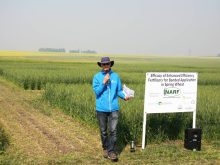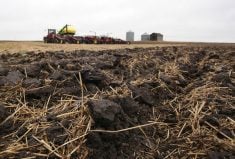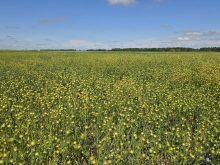As combine architecture maxed out at Classes 9 and 10 because of weight, farmers started paying serious attention to the soil compaction benefits of the uniquely radical Tribine prototypes.
After four prototype versions, the fifth generation production model Tribines started rumbling out of the Kansas factory this month.
By splitting the traditional combine platform into a giant processor on two wheels attached to a giant grain tank on two wheels, the innovative Tribine marks the only fundamental upgrade to combine design since the first self-propelled Fahr combine in 1951. The first self-propelled was patented in 1888.
Read Also

Fertilizer method’s link to emissions studied
A researcher says others studying greenhouse gas emissions aren’t considering how the loss of nitrogen into the atmosphere correlates with fertilizer application or if there is an impact to yield.
Tribine employs two engines, a 6.7 litre Cummins for propulsion and a 9.0 litre Cummins to power the massive threshing plant. Clean grain is transferred to the 1,000 bushel grain cart that rides on its own pair of hydraulically driven tires.
Designer Ben Dillon decided 20 years ago that combines were getting too heavy. He saw that soil compaction resulted in yield losses as high as 10 percent. Ironically, the machine responsible for collecting yield is the same machine that is also responsible for much of the yield reduction.
So Dillon decided to take a fresh look at grain harvest and soil compaction.
Corn best exemplifies the basic compaction challenge with ever-higher yields, ever-wider headers and high performance threshing plants.
As a result, the grain tank fills quickly, causing that expensive piece of machinery to slow down or even stop. Heavy grain carts and tractors run willy-nilly around the field, trying to keep up with the volume of corn.
Many farmers combine with their unload auger running full time, dumping into grain carts pulled alongside.
The Tribine strategy is to use the giant 1,000 bushel grain tank to either unload into a 1,000 bushel semi at the headland or manage the cart to minimize trips across the field. Compaction is reduced, and the combine continues working at peak financial efficiency.
The large capacity tank serves as a buffer, giving the operator more unload options, said Tribine chief engineer Bob Matousek.
“It’s no longer possible to run one big combine with one big grain cart. Today you need two tractors and two big grain carts in the field to keep that one single big combine running,” said Matousek, adding that it’s especially difficult with a 12 row corn head.
“Instead of having to unload every four minutes, the Tribine gives you the option of unloading every 12 minutes, and that changes everything. You can unload the entire 1,000 bushels in just two minutes if that’s what you want.”
Matousek said Tribine has the world’s largest threshing and cleaning system with up to double the cleaning area of other combines. The numbers are pretty impressive.
Rotor diameter is 38 inches and concave wrap is 270 degrees. The cleaning area is more than 13,000 sq. inches. As well, Tribine engineers have developed what they call an advanced pneumatic cleaning system.
“We have our own special way of separating the chaff from the straw as it exits the rotor, so we don’t put it all down on the cleaning system. If you want high cleaning capacity, you concentrate on separating straw from grain, not grain from straw. It’s pretty cool. I can’t tell you how it works today, but you’ll be able to see it at the (U.S.) Farm Progress Show (in Boone, Iowa),” said Matousek.
The twin straw choppers blow material out the left and right sides for a total width of 50 feet. To eliminate the need for deflectors, choppers are designed to throw straw to the farthest points rather than to a point near the combine.
Matousek said that once you’ve figured out how to spread wide, it’s easy to control the straw for a narrow windrow. As for weight and pounds per sq. inch on the soil, he won’t disclose exact numbers.
“Yes, it does look big, but it’s not nearly as heavy as you’d think. We’re no heavier than the big combines other people are making,” he said.
“The tires are new. They’re low sidewall and they’re intended to squat as much as six inches under load. It really spreads out the footprint. Our p.s.i. isn’t as low as tracks, but compaction is low.”
Weight on the front axle has also been reduced.
“On a typical big combine with a wide head and a load of grain, there can be 100,000 pounds on the front axle. We’re not much more than 50,000 lb. on the front axle with a wide head.”
On any centre articulated machine, the point in the middle where the front half meets the rear half is a highly stressed joint. You can envision that it’s even more traumatic on a machine like the Tribine, with a corn head leveraged way out front and a full load in the tank.
Oscillation left-right should be no problem, but the bucking bronco action oscillating up-down at the joint could be catastrophic.
Matousek and his engineers solved the problem, but he won’t give details, other than to imply that people who have seen the system are often perplexed.
“As we started looking at bigger headers, we could see that the weight shifts back and forth and constantly flexes that area of the joint.”
Matousek set out to solve that problem.
“We have a leveraged joint. We don’t ask a short arm to withstand a lot of bending, but that’s about all I can say today.”
The unique twin engine concept is a matter of weight and balance. Matousek said it gives him extreme diversity in dialling in the optimal power level individually for propulsion and for threshing. It also allows him to easily install different engines for different models in the future.
The propulsion engine spins a hydraulic pump, while the larger engine powers the harvest system mechanically. Together, the two engines produce 590 horsepower.
“But I don’t want to go beyond that. I don’t want to teach other people how to do this.”
The Tribine is full-time all-wheel-drive with a hydraulic motor mounted in each wheel. To help minimize compaction, the rear cart tires follow the same path as the front combine tires and are the same size. The centre articulating harvester has a tight turning radius because the rear axle actually pivots to help steer the machine.
“I compare it to the pivoting front axle on your old Radio Flyer little red wagon. Pick any large combine you want and we’ll turn inside it. We have the geometry with the compound steering working pretty well, so the steering cylinders are actually quite small.”
The 500 gallon fuel tank allows 24 hours continuous operation without stopping for fuel. The engines do not require diesel exhaust fluid.
The first production model Tribine will debut at the Farm Progress Show in Boone, Iowa, Aug. 30-Sept. 1.


















